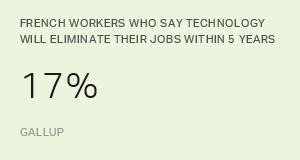Story Highlights
- Many European employees anticipate that technology will change their jobs
- Performance management systems are holding businesses back
- Leaders need to use management tools in partnership with employees
Some predictions about the future of work have been fairly dire; in his recent bestseller Homo Deus: A Brief History of Tomorrow, for example, Israeli historian Yuval Noah Harari discusses the possibility of a growing "useless class" of people whose skills have been made obsolete by automation and AI.
However, a new Gallup study of employees in the UK, Germany, France and Spain finds that relatively few employees in those four countries are worried that their jobs will be eliminated.
Seventeen percent of French employees say it is "very likely" or "somewhat likely" that their current jobs will be eliminated within the next five years as a result of new technology, as do 13% of British employees, 8% of Spanish employees and 7% of workers in Germany.
Of employees who say there have been technology changes at their job in 2017, employees are, in fact, more likely to feel those changes will increase their productivity and the demand for their qualifications in the next three years, though the results vary considerably by country.
Outdated Performance Management Holds Many European Businesses Back
The general conclusion is that while most employees in the four countries studied don't fear the consequences of technological advancement in their working lives, many anticipate significant changes in the way they do their jobs.
To stay valuable to employers, workers will need to spend more time doing things machines have a hard time with -- things like taking initiative, creatively solving problems, collaborating effectively and across teams in their organizations to maximize their contributions.
In turn, organizations will need to adjust their management systems to allow for greater employee autonomy and flexibility, while maintaining accountability and high productivity.
Ironically, in an era of automation, companies that successfully adapt to make the most of their human resources will be the ones with a competitive advantage.
That's why interest in people analytics (PA) is booming as companies try to crack the code on using data to configure their workforces to meet future needs.
So far, the answer has eluded most businesses; labor productivity has been alarmingly flat in Europe's largest economies since 2010.
Our survey results indicate most organizations in France, Germany, Spain and the UK are not ready for successful deployment of PA.
One major barrier is current performance management systems, which often maintain rigidity and outdated incentives. In none of the four countries do more than 30% of employees strongly agree that their performance is managed in a way that motivates them to do outstanding work.
Why Is Performance Management So Important for PA?
All PA projects come down to "solving for performance" -- i.e., helping maximize employees' time and energy.
When we build models to understand and predict employee turnover, we focus on high performers -- the employees we want to keep. When we explore collaboration patterns, we're trying to figure out how employees perform best in teams. When we use machine learning algorithms to support our hiring strategy, we care about candidates' future performance within our organizations.
To draw valuable insights from any analysis, organizations first need to ensure their performance metrics are suitable for PA deployment.
Gallup's work with businesses that struggle with this question points to two key considerations. Delving into these will help ensure analytics data are applied appropriately and that the resulting decisions will have the intended effects on employee positioning and motivation:
- Identify the correct outcomes.
- Ensure all performance measures are transparent and accepted by employees.
Identify the correct outcomes.
Identifying and measuring employee performance will become trickier as many jobs become less based on routines.
The primary consideration in choosing the correct performance measures is that they need to reflect individual-level impact on achieving the organization's goals -- meaning they should meet two conditions:
- they must directly link to organizational success
- they must be in an employee's sphere of control
Failing to meet these conditions can lead to ineffective incentives. For example, if you track your sales team's performance based on the number of meetings they have with prospects, they are going to have more meetings, which may or may not lead to more sales.
Among the four countries, employees in Germany are most likely to say they can see how their work goals connect to their organization's overall goals, followed by those in the UK. Only about one in six employees (17%) in Spain and France strongly agree with this statement.
Identifying the right outcomes for each employee ultimately means measuring and discussing performance in a manner that captures a comprehensive view of the work they do and the value they bring to their jobs every day.
When well-calibrated metrics are used to capture employees' unique contributions, managers and employees can have a more effective dialogue about personal development.
Ensure all performance measures are transparent and accepted by employees.
As any psychologist will attest, the process of analyzing people must be handled carefully. This is just as true for managers employing PA strategies as it is in a therapist's office.
That's because people react to being analyzed -- and their reaction is bound to be negative if they suspect the analyst is not acting entirely with their best interests at heart.
Leaders should, therefore, resist the temptation to use clandestine PA measures -- hoping to avoid "contaminating" the results by alerting employees that they are being evaluated in the first place is misguided.
People care deeply about how their performance is measured, no matter what the purpose. They are very motivated to find out how it is done, and probably will (if they can't, rumors -- accurate or not -- are likely to fill in the gaps).
Employees must also regard their evaluation criteria as fair -- otherwise, they are unlikely to change their behavior based on the results.
For example, if an employee's performance is measured using their manager's subjective rating across 15 vaguely defined competencies that aren't directly tied to organizational success, that employee may (justifiably) disregard the results -- and any efforts to analyze and influence the measure would be wasted.
The proportion of employees in Spain, France, Germany and the UK who strongly agree that the performance reviews they receive are fair range from about one-fifth (19%) in Spain to about one-third (32%) in the UK. In the UK and France, about two-thirds of employees agree, at least somewhat, but this figure falls to 59% in Germany and just 38% in Spain.
In one recent study, Gallup analyzed 559 roles and 360 behavioral job demands to identify the job responsibilities that universally matter most across all types of individual contributor roles.
The results highlighted three performance domains that comprehensively describe and statistically predict overall success in a role:
- Individual achievement (My Work): responsibilities that employees must achieve independently.
- Team collaboration (My Team): how effectively an individual partners with other team members to achieve success.
- Customer value (My Customer): the impact a person's work has on a customer. In this context, customers may be either internal or external to the organization. All employees have customers of some kind, and to be "customer-centric" requires performance expectations that align with customers' needs.
By prioritizing performance expectations using these domains, organizations can help ensure performance achievement and developmental efforts always focus on a comprehensive description of the key aspects of the job that matter most.
The rapid changes business leaders must accommodate in order to stay competitive are unlikely to abate anytime soon.
Some analysts believe that the disruptions AI will bring in the coming decades will be more dramatic than anything we've seen over the last 50 years.
The challenge today is that the cultures of many organizations -- as reflected in the way they measure and recognize employee performance -- are ill-suited for incorporating new data sources that can help their workforces adapt to these changes.
Increasingly, leaders have tools they need to make effective decisions about optimizing the human capital in their organizations -- but unless they use those tools in the spirit of partnership with employees themselves, they may end up doing more harm than good.
This article is part of The Real Future of Work series. Learn more:




